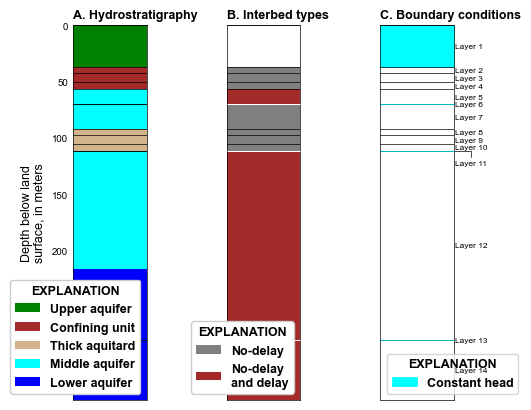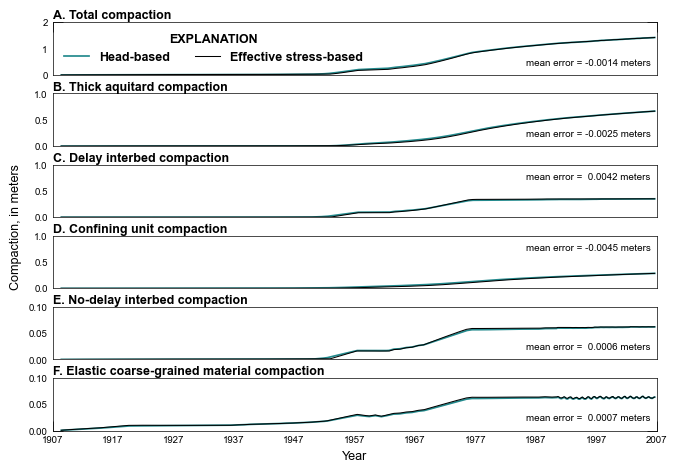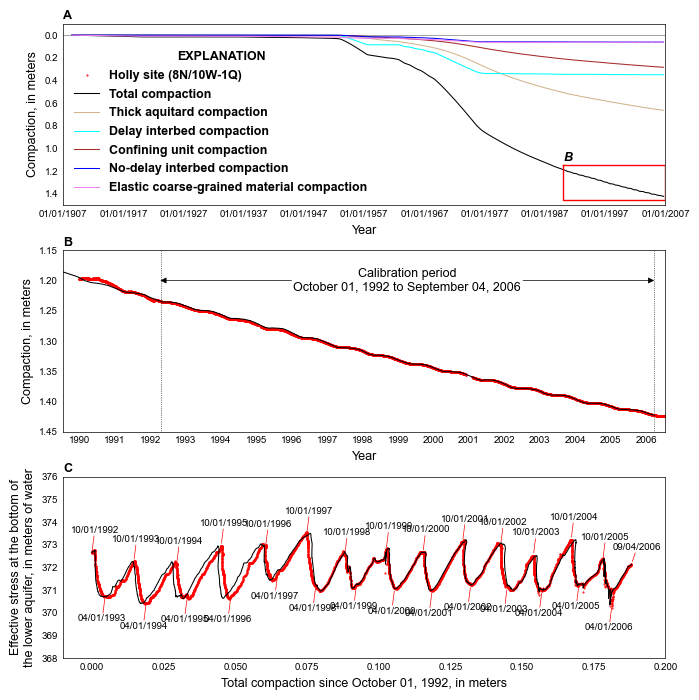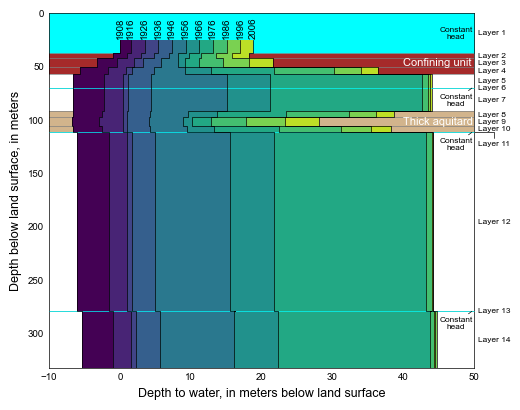This page was generated from
ex-gwf-csub-p03.py.
It's also available as a notebook.
One-dimensional compaction example
A one-dimensional MODFLOW 6 model was developed by Sneed (2008) to simulate aquitard drainage, compaction and, land subsidence at the Holly site, located at the Edwards Air Force base, in response to effective stress changes caused by groundwater pumpage in the Antelope Valley in southern California.
Initial setup
Import dependencies, define the example name and workspace, and read settings from environment variables.
[1]:
import datetime
import os
import pathlib as pl
import flopy
import git
import matplotlib as mpl
import matplotlib.pyplot as plt
import numpy as np
import pandas as pd
import pooch
from flopy.plot.styles import styles
from modflow_devtools.latex import build_table, exp_format, float_format, int_format
from modflow_devtools.misc import get_env, timed
# Example name and workspace paths. If this example is running
# in the git repository, use the folder structure described in
# the README. Otherwise just use the current working directory.
sim_name = "ex-gwf-csub-p03"
try:
root = pl.Path(git.Repo(".", search_parent_directories=True).working_dir)
except:
root = None
workspace = root / "examples" if root else pl.Path.cwd()
figs_path = root / "figures" if root else pl.Path.cwd()
tbls_path = root / "tables" if root else pl.Path.cwd()
data_path = root / "data" / sim_name if root else pl.Path.cwd()
# Settings from environment variables
write = get_env("WRITE", True)
run = get_env("RUN", True)
plot = get_env("PLOT", True)
plot_show = get_env("PLOT_SHOW", True)
plot_save = get_env("PLOT_SAVE", True)
Define parameters
Define model units, parameters and other settings.
[2]:
# Load the constant time series
fname = "boundary_heads.csv"
fpath = pooch.retrieve(
url=f"https://github.com/MODFLOW-USGS/modflow6-examples/raw/master/data/{sim_name}/{fname}",
fname=fname,
path=data_path,
known_hash="md5:8177e15feeeedcdd59ee15745e796e59",
)
csv_head = np.genfromtxt(fpath, names=True, delimiter=",")
# Reformat csv data into format for MODFLOW 6 timeseries file
chd_ts = []
for idx in range(csv_head.shape[0]):
chd_ts.append(
(
csv_head["time"][idx],
csv_head["CHD_L01"][idx],
csv_head["CHD_L06"][idx],
csv_head["CHD_L13"][idx],
)
)
# Simulation starting date and time
dstart = datetime.datetime(1907, 1, 1, 0, 0, 0)
# Create a datetime list for the simulation
date_list = [dstart + datetime.timedelta(days=x) for x in csv_head["time"]]
# Scenario parameters
parameters = {
"ex-gwf-csub-p03a": {
"head_based": True,
"cg_ske": (
0.00e0,
0.00e0,
0.00e0,
0.00e0,
5.42e-6,
0.00e0,
5.42e-6,
0.00e0,
0.00e0,
0.00e0,
0.00e0,
5.42e-6,
0.00e0,
5.42e-6,
),
"pcs0": (
-4.91,
-5.33,
-5.76,
-6.10,
-6.10,
-6.10,
-6.10,
-6.10,
-6.71,
-6.71,
-6.10,
-6.10,
-6.71,
),
"ssv": (
6.6955e-4,
6.6955e-4,
6.6955e-4,
1.2753e-4,
1.2753e-4,
1.2116e-3,
1.2116e-3,
1.2116e-3,
1.2753e-4,
1.2753e-4,
4.7825e-4,
4.7825e-4,
4.7825e-4,
),
"sse": (
5.4202e-6,
5.4202e-6,
5.4202e-6,
5.4202e-6,
5.4202e-6,
5.4202e-6,
5.4202e-6,
5.4202e-6,
5.4202e-6,
5.4202e-6,
5.4202e-6,
5.4202e-6,
5.4202e-6,
),
},
"ex-gwf-csub-p03b": {
"head_based": False,
"cg_ske": (
0.00e0,
0.00e0,
0.00e0,
0.00e0,
6.88e-6,
0.00e0,
6.88e-6,
0.00e0,
0.00e0,
0.00e0,
0.00e0,
6.88e-6,
0.00e0,
6.88e-6,
),
"pcs0": (
47.27,
55.93,
62.76,
75.90,
98.15,
103.33,
111.86,
117.35,
285.60,
339.25,
75.90,
285.60,
339.25,
),
"ssv": (
1.3542e-3,
1.3542e-3,
1.3542e-3,
2.6912e-4,
2.7107e-4,
1.9249e-3,
1.9249e-3,
1.9249e-3,
1.4632e-4,
2.1655e-4,
2.2717e-4,
4.8671e-4,
1.0170e-3,
),
"sse": (
8.5697e-6,
8.5697e-6,
8.5697e-6,
1.2559e-5,
1.1538e-5,
3.4235e-5,
3.4235e-5,
3.4235e-5,
6.3990e-6,
9.2419e-6,
1.0292e-5,
7.5887e-6,
6.8638e-6,
),
},
}
# Model units
length_units = "meters"
time_units = "days"
# Model parameters
nper = 353
nlay = 14
ncol = 1
nrow = 1
delr = 1.0
delc = 1.0
top = 0.0
botm = (
-36.8811,
-42.3676,
-50.5973,
-56.9981,
-69.7998,
-70.1046,
-92.0504,
-97.2321,
-105.7666,
-111.2530,
-111.5578,
-278.8945,
-279.1993,
-332.5398,
)
strt = (
0.00,
1.57,
3.38,
5.56,
6.77,
6.77,
6.77,
6.77,
6.77,
6.77,
6.77,
6.77,
5.55,
5.55,
)
icelltype = 0
k33 = (
9.14e-3,
3.66e-6,
3.66e-6,
3.66e-6,
9.14e-3,
9.14e-3,
9.14e-3,
4.57e-6,
4.57e-6,
4.57e-6,
9.14e-3,
9.14e-3,
9.14e-3,
9.14e-3,
)
iconvert = (
1,
0,
0,
0,
0,
0,
0,
0,
0,
0,
0,
0,
0,
0,
)
sgm = 1.7
sgs = 2.0
cg_theta = 0.3
ib_cellid = (
(1, 0, 0),
(2, 0, 0),
(3, 0, 0),
(4, 0, 0),
(6, 0, 0),
(7, 0, 0),
(8, 0, 0),
(9, 0, 0),
(11, 0, 0),
(13, 0, 0),
(4, 0, 0),
(11, 0, 0),
(13, 0, 0),
)
ib_ctype = (
"nodelay",
"nodelay",
"nodelay",
"nodelay",
"nodelay",
"nodelay",
"nodelay",
"nodelay",
"nodelay",
"nodelay",
"delay",
"delay",
"delay",
)
ib_thickness = (
5.48649,
8.22969,
6.4008,
2.7432,
0.6096,
5.1817,
8.53449,
5.4864,
7.6201,
0.9144,
2.7432,
3.0480,
2.7432,
)
ib_rnb = (
1.0,
1.0,
1.0,
1.0,
1.0,
1.0,
1.0,
1.0,
1.0,
1.0,
1.92,
1.66,
2.85,
)
ib_theta = 0.30
ib_kv = (
999.0,
999.0,
999.0,
999.0,
999.0,
999.0,
999.0,
999.0,
999.0,
999.0,
4.57e-6,
4.57e-6,
4.57e-6,
)
ib_head = (
999.0,
999.0,
999.0,
999.0,
999.0,
999.0,
999.0,
999.0,
999.0,
999.0,
6.77,
6.77,
5.55,
)
ib_name = (
"CUNIT",
"CUNIT",
"CUNIT",
"NODELAY",
"NODELAY",
"AQUITARD",
"AQUITARD",
"AQUITARD",
"NODELAY",
"NODELAY",
"DELAY",
"DELAY",
"DELAY",
)
# Temporal discretization
tdis_ds = []
for idx in range(82):
tdis_ds.append((365.25, 12, 1.0))
for idx in range(82, nper):
tdis_ds.append((22.0, 22, 1.0))
# Constant head cells
c6 = []
for k, tag in zip(
(
0,
5,
10,
12,
),
("upper", "middle", "middle", "lower"),
):
c6.append([k, 0, 0, tag])
# Solver parameters
nouter = 200
ninner = 100
hclose = 1e-6
rclose = 1e-3
linaccel = "cg"
relax = 0.97
Model setup
Define functions to build models, write input files, and run the simulation.
[3]:
def build_models(
name,
subdir_name=".",
head_based=True,
cg_ske=1e-3,
pcs0=0.0,
ssv=1e-1,
sse=1e-3,
):
sim_ws = os.path.join(workspace, name)
if subdir_name is not None:
sim_ws = os.path.join(sim_ws, subdir_name)
sim = flopy.mf6.MFSimulation(sim_name=name, sim_ws=sim_ws, exe_name="mf6")
flopy.mf6.ModflowTdis(sim, nper=nper, perioddata=tdis_ds, time_units=time_units)
flopy.mf6.ModflowIms(
sim,
print_option="summary",
outer_maximum=nouter,
outer_dvclose=hclose,
linear_acceleration=linaccel,
inner_maximum=ninner,
inner_dvclose=hclose,
relaxation_factor=relax,
rcloserecord=f"{rclose} strict",
)
gwf = flopy.mf6.ModflowGwf(
sim,
modelname=name,
save_flows=True,
)
flopy.mf6.ModflowGwfdis(
gwf,
length_units=length_units,
nlay=nlay,
nrow=nrow,
ncol=ncol,
delr=delr,
delc=delc,
top=top,
botm=botm,
)
# gwf obs
opth = f"{name}.gwf.obs"
cpth = opth + ".csv"
obs_array = []
for k in range(nlay):
obs_array.append(
[
f"HD{k + 1:02d}",
"HEAD",
(k, 0, 0),
]
)
flopy.mf6.ModflowUtlobs(
gwf,
digits=10,
print_input=True,
filename=opth,
continuous={cpth: obs_array},
)
flopy.mf6.ModflowGwfic(gwf, strt=strt)
flopy.mf6.ModflowGwfnpf(
gwf,
icelltype=icelltype,
k=k33,
k33=k33,
save_specific_discharge=True,
)
flopy.mf6.ModflowGwfsto(gwf, iconvert=iconvert, ss=0.0, sy=0, transient={0: True})
if head_based:
hb_bool = True
tsgm = None
tsgs = None
else:
hb_bool = None
tsgm = sgm
tsgs = sgs
sub6 = []
for idx, cdelay in enumerate(ib_ctype):
sub6.append(
[
idx,
ib_cellid[idx],
cdelay,
pcs0[idx],
ib_thickness[idx],
ib_rnb[idx],
ssv[idx],
sse[idx],
ib_theta,
ib_kv[idx],
ib_head[idx],
ib_name[idx],
]
)
csub = flopy.mf6.ModflowGwfcsub(
gwf,
print_input=True,
save_flows=True,
head_based=hb_bool,
specified_initial_interbed_state=True,
update_material_properties=True,
ndelaycells=39,
boundnames=True,
beta=4.65120000e-10,
gammaw=9806.65,
ninterbeds=len(sub6),
sgm=tsgm,
sgs=tsgs,
cg_theta=cg_theta,
cg_ske_cr=cg_ske,
packagedata=sub6,
)
opth = f"{name}.csub.obs"
csub_csv = opth + ".csv"
obs = [
("cunit", "interbed-compaction", "cunit"),
("aquitard", "interbed-compaction", "aquitard"),
("nodelay", "interbed-compaction", "nodelay"),
("delay", "interbed-compaction", "delay"),
("es14", "estress-cell", (nlay - 1, 0, 0)),
]
for k in (1, 2, 3, 4, 6, 7, 8, 9, 11, 13):
tag = f"tc{k + 1:02d}"
obs.append(
(
tag,
"compaction-cell",
(k, 0, 0),
)
)
tag = f"skc{k + 1:02d}"
obs.append(
(
tag,
"coarse-compaction",
(k, 0, 0),
)
)
orecarray = {csub_csv: obs}
csub.obs.initialize(
filename=opth, digits=10, print_input=True, continuous=orecarray
)
chd = flopy.mf6.ModflowGwfchd(gwf, stress_period_data={0: c6})
# initialize chd time series
csubnam = f"{sim_name}.head.ts"
chd.ts.initialize(
filename=csubnam,
timeseries=chd_ts,
time_series_namerecord=[
"upper",
"middle",
"lower",
],
interpolation_methodrecord=[
"linear",
"linear",
"linear",
],
sfacrecord=[
"1.0",
"1.0",
"1.0",
],
)
flopy.mf6.ModflowGwfoc(
gwf,
printrecord=[("BUDGET", "ALL")],
)
return sim
def write_models(sim, silent=True):
sim.write_simulation(silent=silent)
@timed
def run_models(sim, silent=True):
success, buff = sim.run_simulation(silent=silent)
assert success, buff
Plotting results
Define functions to plot model results.
[4]:
# Figure properties
xticks = (1907, 1917, 1927, 1937, 1947, 1957, 1967, 1977, 1987, 1997, 2007)
s = (
"01-01-1907",
"01-01-1917",
"01-01-1927",
"01-01-1937",
"01-01-1947",
"01-01-1957",
"01-01-1967",
"01-01-1977",
"01-01-1987",
"01-01-1997",
"01-01-2007",
)
df_xticks = [datetime.datetime.strptime(ss, "%m-%d-%Y").date() for ss in s]
df_xticks1 = [
datetime.datetime.strptime(f"{yr:04d}-01-01", "%Y-%m-%d").date()
for yr in range(1990, 2007)
]
pcomp = (
"TOTAL",
"AQUITARD",
"DELAY",
"CUNIT",
"NODELAY",
"SKELETAL",
)
clabels = (
"Total compaction",
"Thick aquitard compaction",
"Delay interbed compaction",
"Confining unit compaction",
"No-delay interbed compaction",
"Elastic coarse-grained material compaction",
)
llabels = (0, 1, 2, 3, 4, 5, 6, 7, 8, 9, 10, 11, 12, 13)
zelevs = [top]
edges = [(0, 0)]
for z in botm:
zelevs.append(z)
edges.append((-z, -z))
figure_size = (6.8, 3.4)
arrow_props = dict(facecolor="black", arrowstyle="-", lw=0.5)
def export_tables(silent=True):
if plot_save:
name = list(parameters.keys())[1]
caption = f"Aquifer properties for example {sim_name}."
headings = (
"Layer",
"Thickness",
"Hydraulic conductivity",
"Initial head",
)
fpth = tbls_path / f"{sim_name}-01.tex"
dtype = [
("k", "U30"),
("thickness", "U30"),
("k33", "U30"),
("h0", "U30"),
]
arr = np.zeros(nlay, dtype=dtype)
for k in range(nlay):
arr["k"][k] = int_format(k + 1)
arr["thickness"][k] = float_format(zelevs[k] - zelevs[k + 1])
arr["k33"][k] = exp_format(k33[k])
arr["h0"][k] = float_format(strt[k])
if not silent:
print(f"creating...'{fpth}'")
col_widths = (0.1, 0.15, 0.30, 0.25)
build_table(caption, fpth, arr, headings=headings, col_widths=col_widths)
caption = f"Interbed properties for example {sim_name}."
headings = (
"Interbed",
"Layer",
"Thickness",
"Initial stress",
)
fpth = tbls_path / f"{sim_name}-02.tex"
dtype = [
("ib", "U30"),
("k", "U30"),
("thickness", "U30"),
("pcs0", "U30"),
]
arr = np.zeros(len(ib_ctype), dtype=dtype)
for idx, ctype in enumerate(ib_ctype):
arr["ib"][idx] = int_format(idx + 1)
arr["k"][idx] = int_format(ib_cellid[idx][0] + 1)
if ctype == "nodelay":
arr["thickness"][idx] = float_format(ib_thickness[idx])
else:
b = ib_thickness[idx] * ib_rnb[idx]
arr["thickness"][idx] = float_format(b)
arr["pcs0"][idx] = float_format(parameters[name]["pcs0"][idx])
if not silent:
print(f"creating...'{fpth}'")
build_table(caption, fpth, arr, headings=headings)
caption = f"Aquifer storage properties for example {sim_name}."
headings = (
"Layer",
"Specific Storage",
)
fpth = tbls_path / f"{sim_name}-03.tex"
dtype = [("k", "U30"), ("ss", "U30")]
arr = np.zeros(4, dtype=dtype)
for idx, k in enumerate((4, 6, 11, 13)):
arr["k"][idx] = int_format(k + 1)
arr["ss"][idx] = exp_format(parameters[name]["cg_ske"][k])
if not silent:
print(f"creating...'{fpth}'")
col_widths = (0.1, 0.25)
build_table(caption, fpth, arr, headings=headings, col_widths=col_widths)
caption = "Interbed storage properties for example {}.".format(sim_name)
headings = (
"Interbed",
"Layer",
"Inelastic \\newline Specific \\newline Storage",
"Elastic \\newline Specific \\newline Storage",
)
fpth = tbls_path / f"{sim_name}-04.tex"
dtype = [
("ib", "U30"),
("k", "U30"),
("ssv", "U30"),
("sse", "U30"),
]
arr = np.zeros(len(ib_ctype), dtype=dtype)
for idx, ctype in enumerate(ib_ctype):
arr["ib"][idx] = int_format(idx + 1)
arr["k"][idx] = int_format(ib_cellid[idx][0] + 1)
arr["ssv"][idx] = exp_format(parameters[name]["ssv"][idx])
arr["sse"][idx] = exp_format(parameters[name]["sse"][idx])
if not silent:
print(f"creating...'{fpth}'")
col_widths = (0.2, 0.2, 0.2, 0.2)
build_table(
caption,
fpth,
arr,
headings=headings,
col_widths=col_widths,
)
def get_obs_dataframe(file_name, hash):
fpath = pooch.retrieve(
url=f"https://github.com/MODFLOW-USGS/modflow6-examples/raw/master/data/{sim_name}/{file_name}",
fname=file_name,
path=data_path,
known_hash=f"md5:{hash}",
)
df = pd.read_csv(fpath, index_col=0)
df.index = pd.to_datetime(df.index.values)
df.rename({"mean": "observed"}, inplace=True, axis=1)
return df
def process_sim_csv(
fpth, index_tag="time", origin_str="1908-05-09 00:00:00.000000", **kwargs
):
v = pd.read_csv(fpth, **kwargs)
v["date"] = pd.to_datetime(v[index_tag].values, unit="d", origin=origin_str)
v.set_index("date", inplace=True)
v.drop(columns=index_tag, inplace=True)
col_list = list(v.columns)
return v, col_list
def get_sim_dataframe(fpth, index_tag="time", origin_str="1908-05-09 00:00:00.000000"):
v, col_list = process_sim_csv(fpth, index_tag=index_tag, origin_str=origin_str)
# calculate total skeletal and total
shape = v[col_list[0]].values.shape[0]
s = np.zeros(shape, dtype=float)
# skeletal
for tag in col_list:
if "SKC" in tag[:3]:
s += v[tag].values
v["SKELETAL"] = s.copy()
# total
s[:] = 0.0
for tag in col_list:
if "TC" in tag[:2]:
s += v[tag].values
v["TOTAL"] = s.copy()
for tag in col_list:
if "TC" in tag[:2] or "SKC" in tag[:3]:
v.drop(columns=tag, inplace=True)
return v
def dataframe_interp(df_in, new_index):
df_out = pd.DataFrame(index=new_index)
df_out.index.name = df_in.index.name
for colname, col in df_in.items():
df_out[colname] = np.interp(new_index, df_in.index, col)
return df_out
def process_csub_obs(fpth):
tdata = flopy.utils.Mf6Obs(fpth).data
dtype = [
("totim", float),
("CUNIT", float),
("AQUITARD", float),
("NODELAY", float),
("DELAY", float),
("SKELETAL", float),
("TOTAL", float),
]
# create structured array and fill time
v = np.zeros(tdata.shape[0], dtype=dtype)
v["totim"] = tdata["totim"]
v["totim"] /= 365.25
v["totim"] += 1908.353182752
# transfer data from temporary storage
for key in pcomp:
if key != "TOTAL" and key != "SKELETAL":
v[key] = tdata[key].copy()
# calculate skeletal
for key in tdata.dtype.names[1:]:
if "SKC" in key[:3]:
v["SKELETAL"] += tdata[key]
# calculate total
for key in tdata.dtype.names[1:]:
if "TC" in key[:2]:
v["TOTAL"] += tdata[key]
return v
def set_label(label, text="text"):
if label == "":
label = text
else:
label = None
return label
def print_label(ax, zelev, k, fontsize=6):
zmax = zelev[-1][0]
z0 = zelev[k][0]
z1 = zelev[k + 1][0]
z = 1 - 0.5 * (z0 + z1) / zmax
text = f"Layer {k + 1}"
if k == 10:
arrowprops = dict(
facecolor="black",
arrowstyle="-",
lw=0.5,
connectionstyle="angle,angleA=-90,angleB=180,rad=0",
shrinkA=0,
shrinkB=0,
)
ax.annotate(
text,
xy=(1, z),
xytext=(1.01, z - 0.025),
ha="left",
va="top",
zorder=103,
xycoords="axes fraction",
textcoords="axes fraction",
arrowprops=arrowprops,
fontsize=fontsize,
)
else:
ax.text(
1.01,
z,
text,
fontsize=fontsize,
ha="left",
va="center",
transform=plt.gca().transAxes,
zorder=103,
)
return
def constant_heads(ax, annotate=False, fontsize=6, xrange=(0, 1)):
arrowprops = dict(facecolor="black", arrowstyle="-", lw=0.5, shrinkA=0, shrinkB=0)
label = ""
for k in [0, 5, 10, 12]:
label = set_label(label, text="Constant head")
color = "cyan"
if k == 0:
zo = 1
lw = 0.5
else:
zo = 200
lw = 0.5
ax.fill_between(
xrange,
edges[k],
y2=edges[k + 1],
color=color,
lw=lw,
label=label,
zorder=zo,
)
if annotate:
text = "Constant\nhead"
x = 47.5
if k == 0:
y = 0.5 * (edges[k][0] + edges[k + 1][0])
ax.text(
x,
y,
text,
fontsize=fontsize,
ha="center",
va="center",
zorder=203,
)
else:
y = edges[k + 1][0]
ax.annotate(
text,
xy=(x + 2.25, y),
xytext=(x, y + 5),
ha="center",
va="top",
zorder=203,
arrowprops=arrowprops,
fontsize=fontsize,
)
return
def plot_grid(silent=True):
with styles.USGSMap():
# # load the model
# sim = flopy.mf6.MFSimulation.load(sim_name=name, sim_ws=sim_ws)
# gwf = sim.get_model(name)
xrange = (0, 1)
chds = (5, 10, 12)
fig, axes = plt.subplots(nrows=1, ncols=3, sharey=True, figsize=(5.1, 4.0))
plt.subplots_adjust(wspace=1)
for idx, ax in enumerate(axes):
ax.set_xlim(xrange)
ax.set_ylim(edges[-1][0], 0)
for edge in edges:
ax.plot(xrange, edge, lw=0.5, color="black")
ax.tick_params(
axis="x", which="both", bottom=False, top=False, labelbottom=False
)
ax.tick_params(axis="y", which="both", right=False, labelright=False)
ax = axes[0]
ax.fill_between(
xrange,
edges[0],
y2=edges[1],
color="green",
lw=0,
label="Upper aquifer",
)
label = ""
for k in (1, 2, 3):
label = set_label(label, text="Confining unit")
ax.fill_between(
xrange, edges[k], y2=edges[k + 1], color="brown", lw=0, label=label
)
label = ""
for k in (7, 8, 9):
label = set_label(label, text="Thick aquitard")
ax.fill_between(
xrange, edges[k], y2=edges[k + 1], color="tan", lw=0, label=label
)
# middle aquifer
midz = 825.0 / 3.8081
midz = [edges[4], edges[7], edges[10], (midz, midz)]
ax.fill_between(
xrange, midz[0], y2=midz[1], color="cyan", lw=0, label="Middle aquifer"
)
ax.fill_between(xrange, midz[2], y2=midz[3], color="cyan", lw=0)
# lower aquifer
ax.fill_between(
xrange,
midz[-1],
y2=edges[-1],
color="blue",
lw=0,
label="Lower aquifer",
)
styles.graph_legend(ax, loc="lower right", frameon=True, framealpha=1)
styles.heading(ax=ax, letter="A", heading="Hydrostratigraphy")
styles.remove_edge_ticks(ax)
ax.set_ylabel("Depth below land\nsurface, in meters")
# csub interbeds
ax = axes[1]
nodelay = (1, 2, 3, 6, 7, 8, 9)
label = ""
for k in nodelay:
label = set_label(label, text="No-delay")
ax.fill_between(
xrange, edges[k], y2=edges[k + 1], color="0.5", lw=0, label=label
)
comb = [4, 11, 13]
label = ""
for k in comb:
label = set_label(label, text="No-delay\nand delay")
ax.fill_between(
xrange, edges[k], y2=edges[k + 1], color="brown", lw=0, label=label
)
for k in chds:
ax.fill_between(
xrange,
edges[k],
y2=edges[k + 1],
color="white",
lw=0.75,
zorder=100,
)
leg = styles.graph_legend(ax, loc="lower right", frameon=True, framealpha=1)
leg.set_zorder(100)
styles.heading(ax=ax, letter="B", heading="Interbed types")
styles.remove_edge_ticks(ax)
# boundary conditions
ax = axes[2]
constant_heads(ax)
for k in llabels:
print_label(ax, edges, k)
styles.graph_legend(ax, loc="lower left", frameon=True)
styles.heading(ax=ax, letter="C", heading="Boundary conditions")
styles.remove_edge_ticks(ax)
fig.tight_layout(pad=0.5)
if plot_show:
plt.show()
if plot_save:
fpth = figs_path / f"{sim_name}-grid.png"
if not silent:
print(f"saving...'{fpth}'")
fig.savefig(fpth)
def plot_boundary_heads(silent=True):
with styles.USGSPlot():
def process_dtw_obs(fpth):
v = flopy.utils.Mf6Obs(fpth).data
v["totim"] /= 365.25
v["totim"] += 1908.353182752
for key in v.dtype.names[1:]:
v[key] *= -1.0
return v
name = list(parameters.keys())[0]
pth = os.path.join(workspace, name, f"{name}.gwf.obs.csv")
hdata = process_dtw_obs(pth)
pheads = ("HD01", "HD12", "HD14")
hlabels = ("Upper aquifer", "Middle aquifer", "Lower aquifer")
hcolors = ("green", "cyan", "blue")
fig, ax = plt.subplots(nrows=1, ncols=1, figsize=(6.8, 6.8 / 3))
ax.set_xlim(1907, 2007)
ax.set_xticks(xticks)
ax.set_ylim(50.0, -10.0)
ax.set_yticks(sorted([50.0, 40.0, 30.0, 20.0, 10.0, 0.0, -10.0]))
ax.plot([1907, 2007], [0, 0], lw=0.5, color="0.5")
for idx, key in enumerate(pheads):
ax.plot(
hdata["totim"],
hdata[key],
lw=0.75,
color=hcolors[idx],
label=hlabels[idx],
)
styles.graph_legend(ax=ax, frameon=False)
ax.set_ylabel(f"Depth to water, in {length_units}")
ax.set_xlabel("Year")
styles.remove_edge_ticks(ax=ax)
fig.tight_layout()
if plot_show:
plt.show()
if plot_save:
fpth = figs_path / f"{sim_name}-01.png"
if not silent:
print(f"saving...'{fpth}'")
fig.savefig(fpth)
def plot_head_es_comparison(silent=True):
with styles.USGSPlot() as fs:
name = list(parameters.keys())[0]
pth = os.path.join(workspace, name, f"{name}.csub.obs.csv")
hb = process_csub_obs(pth)
name = list(parameters.keys())[1]
pth = os.path.join(workspace, name, f"{name}.csub.obs.csv")
es = process_csub_obs(pth)
ymin = (2.0, 1, 1, 1, 0.1, 0.1)
me = {}
for idx, key in enumerate(pcomp):
v = (es[key] - hb[key]).mean()
me[key] = v
fig, axes = plt.subplots(nrows=6, ncols=1, sharex=True, figsize=(6.8, 4.7))
for idx, key in enumerate(pcomp):
label = clabels[idx]
ax = axes[idx]
ax.set_xlim(1907, 2007)
ax.set_ylim(0, ymin[idx])
ax.set_xticks(xticks)
stext = "none"
otext = "none"
if idx == 0:
stext = "Effective stress-based"
otext = "Head-based"
mtext = f"mean error = {me[key]:7.4f} {length_units}"
ax.plot(hb["totim"], hb[key], color="#238A8DFF", lw=1.25, label=otext)
ax.plot(
es["totim"],
es[key],
color="black",
lw=0.75,
label=stext,
zorder=101,
)
ltext = chr(ord("A") + idx)
htext = f"{label}"
styles.heading(ax, letter=ltext, heading=htext)
va = "bottom"
ym = 0.15
if idx in [2, 3]:
va = "top"
ym = 0.85
ax.text(
0.99,
ym,
mtext,
ha="right",
va=va,
transform=ax.transAxes,
fontsize=7,
)
styles.remove_edge_ticks(ax=ax)
if idx == 0:
styles.graph_legend(ax, loc="center left", ncol=2)
if idx == 5:
ax.set_xlabel("Year")
axp1 = fig.add_subplot(1, 1, 1, frameon=False)
axp1.tick_params(
labelcolor="none", top="off", bottom="off", left="off", right="off"
)
axp1.set_xlim(0, 1)
axp1.set_xticks([0, 1])
axp1.set_ylim(0, 1)
axp1.set_yticks([0, 1])
axp1.set_ylabel(f"Compaction, in {length_units}")
axp1.yaxis.set_label_coords(-0.05, 0.5)
styles.remove_edge_ticks(ax)
fig.tight_layout(pad=0.0001)
if plot_show:
plt.show()
if plot_save:
fpth = figs_path / f"{sim_name}-02.png"
if not silent:
print(f"saving...'{fpth}'")
fig.savefig(fpth)
def plot_calibration(silent=True):
with styles.USGSPlot():
name = list(parameters.keys())[1]
fpath = os.path.join(workspace, name, f"{name}.csub.obs.csv")
df_sim = get_sim_dataframe(fpath)
df_sim.rename({"TOTAL": "simulated"}, inplace=True, axis=1)
fname = "boundary_heads.csv"
fpath = pooch.retrieve(
url=f"https://github.com/MODFLOW-USGS/modflow6-examples/raw/master/data/{sim_name}/{fname}",
fname=fname,
path=data_path,
known_hash="md5:8177e15feeeedcdd59ee15745e796e59",
)
df_obs_heads, col_list = process_sim_csv(fpath)
ccolors = (
"black",
"tan",
"cyan",
"brown",
"blue",
"violet",
)
xf0 = datetime.datetime(1907, 1, 1, 0, 0, 0)
xf1 = datetime.datetime(2007, 1, 1, 0, 0, 0)
xf0s = datetime.datetime(1990, 1, 1, 0, 0, 0)
xf1s = datetime.datetime(2007, 1, 1, 0, 0, 0)
xc0 = datetime.datetime(1992, 10, 1, 0, 0, 0)
xc1 = datetime.datetime(2006, 9, 4, 0, 0, 0)
dx = xc1 - xc0
xca = xc0 + dx / 2
# get observation data
df = get_obs_dataframe(
file_name="008N010W01Q005S_obs.csv", hash="96dd2d0f0eca8c0293275bf87073547e"
)
ix0 = df.index.get_loc("2006-09-04 00:00:00")
offset = df_sim["simulated"].values[-1] - df.observed.values[ix0]
df.observed += offset
# -- subplot a -----------------------------------------------------------
# build box for subplot B
o = datetime.timedelta(31)
ix = (xf0s, xf0s, xf1s - o, xf1s - o, xf0s)
iy = (1.15, 1.45, 1.45, 1.15, 1.15)
# -- subplot a -----------------------------------------------------------
# -- subplot c -----------------------------------------------------------
# get observations
df_pc = get_obs_dataframe(
file_name="008N010W01Q005S_1D.csv", hash="167f83f51692165394442b0eb1fec45e"
)
# get index for start of calibration period for subplot c
ix0 = df_sim.index.get_loc("1992-10-01 12:00:00")
# get initial simulated compaction
cstart = df_sim.simulated[ix0]
# cut off initial portion of simulated compaction
df_sim_pc = df_sim[ix0:].copy()
# reset initial compaction to 0.
df_sim_pc.simulated -= cstart
# reset simulated so maximum compaction is the same
offset = df_pc.observed.values.max() - df_sim_pc.simulated.values[-1]
df_sim.simulated += offset
# interpolate subsidence observations to the simulation index for subplot c
df_iobs_pc = dataframe_interp(df_pc, df_sim_pc.index)
# truncate head to start of observations
head_pc = dataframe_interp(df_obs_heads, df_sim_pc.index)
# calculate geostatic stress
gs = sgm * (0.0 - head_pc.CHD_L01.values) + sgs * (
head_pc.CHD_L01.values - botm[-1]
)
# calculate hydrostatic stress for subplot c
u = head_pc.CHD_L13.values - botm[-1]
# calculate effective stress
es_obs = gs - u
# set up indices for date text for plot c
locs = [f"{yr:04d}-10-01 12:00:00" for yr in range(1992, 2006)]
locs += [f"{yr:04d}-04-01 12:00:00" for yr in range(1993, 2007)]
locs += ["2006-09-04 12:00:00"]
ixs = [head_pc.index.get_loc(loc) for loc in locs]
# -- subplot c -----------------------------------------------------------
ctext = "Calibration period\n{} to {}".format(
xc0.strftime("%B %d, %Y"), xc1.strftime("%B %d, %Y")
)
fig, axes = plt.subplots(nrows=3, ncols=1, figsize=(6.8, 6.8))
# -- plot a --------------------------------------------------------------
ax = axes.flat[0]
ax.set_xlim(xf0, xf1)
ax.plot([xf0, xf1], [0, 0], lw=0.5, color="0.5")
ax.plot(
[
xf0,
],
[
-10,
],
marker=".",
ms=1,
lw=0,
color="red",
label="Holly site (8N/10W-1Q)",
)
for idx, key in enumerate(pcomp):
if key == "TOTAL":
key = "simulated"
color = ccolors[idx]
label = clabels[idx]
ax.plot(
df_sim.index.values,
df_sim[key].values,
color=color,
label=label,
lw=0.75,
)
ax.plot(ix, iy, lw=1.0, color="red", zorder=200)
styles.add_text(ax=ax, text="B", x=xf0s, y=1.14, transform=False)
ax.set_ylim(1.5, -0.1)
ax.xaxis.set_ticks(df_xticks)
ax.xaxis.set_major_formatter(mpl.dates.DateFormatter("%m/%d/%Y"))
ax.set_ylabel(f"Compaction, in {length_units}")
ax.set_xlabel("Year")
styles.graph_legend(ax=ax, frameon=False)
styles.heading(ax, letter="A")
styles.remove_edge_ticks(ax=ax)
# -- plot b --------------------------------------------------------------
ax = axes.flat[1]
ax.set_xlim(xf0s, xf1s)
ax.set_ylim(1.45, 1.15)
ax.plot(
df.index.values,
df["observed"].values,
marker=".",
ms=1,
lw=0,
color="red",
)
ax.plot(
df_sim.index.values,
df_sim["simulated"].values,
color="black",
label=label,
lw=0.75,
)
# plot lines for calibration
ax.plot([xc0, xc0], [1.45, 1.15], color="black", lw=0.5, ls=":")
ax.plot([xc1, xc1], [1.45, 1.15], color="black", lw=0.5, ls=":")
styles.add_annotation(
ax=ax,
text=ctext,
italic=False,
bold=False,
xy=(xc0 - o, 1.2),
xytext=(xca, 1.2),
ha="center",
va="center",
arrowprops=dict(arrowstyle="-|>", fc="black", lw=0.5),
color="none",
bbox=dict(boxstyle="square,pad=-0.07", fc="none", ec="none"),
)
styles.add_annotation(
ax=ax,
text=ctext,
italic=False,
bold=False,
xy=(xc1 + o, 1.2),
xytext=(xca, 1.2),
ha="center",
va="center",
arrowprops=dict(arrowstyle="-|>", fc="black", lw=0.5),
bbox=dict(boxstyle="square,pad=-0.07", fc="none", ec="none"),
)
ax.yaxis.set_ticks(np.linspace(1.15, 1.45, 7))
ax.xaxis.set_ticks(df_xticks1)
ax.xaxis.set_major_locator(mpl.dates.YearLocator())
ax.xaxis.set_minor_locator(mpl.dates.YearLocator(month=6, day=15))
ax.xaxis.set_major_formatter(mpl.ticker.NullFormatter())
ax.xaxis.set_minor_formatter(mpl.dates.DateFormatter("%Y"))
ax.tick_params(axis="x", which="minor", length=0)
ax.set_ylabel(f"Compaction, in {length_units}")
ax.set_xlabel("Year")
styles.heading(ax, letter="B")
styles.remove_edge_ticks(ax=ax)
# -- plot c --------------------------------------------------------------
ax = axes.flat[2]
ax.set_xlim(-0.01, 0.2)
ax.set_ylim(368, 376)
ax.plot(
df_iobs_pc.observed.values,
es_obs,
marker=".",
ms=1,
color="red",
lw=0,
label="Holly site (8N/10W-1Q)",
)
ax.plot(
df_sim_pc.simulated.values,
df_sim_pc.ES14.values,
color="black",
lw=0.75,
label="Simulated",
)
for idx, ixc in enumerate(ixs):
text = "{}".format(df_iobs_pc.index[ixc].strftime("%m/%d/%Y"))
if df_iobs_pc.index[ixc].month == 4:
dxc = -0.001
dyc = -1
elif df_iobs_pc.index[ixc].month == 9:
dxc = 0.002
dyc = 0.75
else:
dxc = 0.001
dyc = 1
xc = df_iobs_pc.observed[ixc]
yc = es_obs[ixc]
styles.add_annotation(
ax=ax,
text=text,
italic=False,
bold=False,
xy=(xc, yc),
xytext=(xc + dxc, yc + dyc),
ha="center",
va="center",
fontsize=7,
arrowprops=dict(arrowstyle="-", color="red", fc="red", lw=0.5),
bbox=dict(boxstyle="square,pad=-0.15", fc="none", ec="none"),
)
xtext = "Total compaction since {}, in {}".format(
df_sim_pc.index[0].strftime("%B %d, %Y"), length_units
)
ytext = (
"Effective stress at the bottom of\nthe lower aquifer, in "
+ f"{length_units} of water"
)
ax.set_xlabel(xtext)
ax.set_ylabel(ytext)
styles.heading(ax, letter="C")
styles.remove_edge_ticks(ax=ax)
styles.remove_edge_ticks(ax)
# finalize figure
fig.tight_layout(pad=0.01)
if plot_show:
plt.show()
if plot_save:
fpth = figs_path / f"{sim_name}-03.png"
if not silent:
print(f"saving...'{fpth}'")
fig.savefig(fpth)
def plot_vertical_head(silent=True):
with styles.USGSPlot() as fs:
name = list(parameters.keys())[1]
pth = os.path.join(workspace, name, f"{name}.gwf.obs.csv")
df_heads, col_list = process_sim_csv(
pth, origin_str="1908-05-09 00:00:00.000000"
)
df_heads_year = df_heads.groupby(df_heads.index.year).mean()
def get_colors(vmax=6):
# set color
cmap = plt.get_cmap("viridis")
cNorm = mpl.colors.Normalize(vmin=0, vmax=vmax)
scalarMap = mpl.cm.ScalarMappable(norm=cNorm, cmap=cmap)
colors = []
for ic in range(vmax):
colors.append(scalarMap.to_rgba(ic))
return colors
def build_head_data(df, year=1908):
dfr = df.loc[df.index == year]
xlabel = None
x = []
y = []
for k in range(14):
tag = f"HD{k + 1:02d}"
h = dfr[tag].values[0]
if k == 0:
z0 = -25.0
xlabel = -1.0 * h
else:
z0 = zelevs[k]
z1 = zelevs[k + 1]
h *= -1.0
x += [h, h]
y += [-z0, -z1]
return xlabel, x, y
iyears = (1908, 1916, 1926, 1936, 1946, 1956, 1966, 1976, 1986, 1996, 2006)
colors = get_colors(vmax=len(iyears) - 1)
xrange = (-10, 50)
fig, ax = plt.subplots(nrows=1, ncols=1, sharey=True, figsize=(0.75 * 6.8, 4.0))
ax.set_xlim(xrange)
ax.set_ylim(-botm[-1], 0)
for z in botm:
ax.axhline(y=-z, xmin=-30, xmax=160, lw=0.5, color="0.5")
# add confining units
label = ""
for k in (1, 2, 3):
label = set_label(label, text="Confining unit")
ax.fill_between(
xrange, edges[k], y2=edges[k + 1], color="brown", lw=0, label=label
)
ypos = -0.5 * (zelevs[2] + zelevs[3])
ax.text(
40,
ypos,
"Confining unit",
ha="left",
va="center",
size=8,
color="white",
)
label = ""
for k in (7, 8, 9):
label = set_label(label, text="Thick aquitard")
ax.fill_between(
xrange, edges[k], y2=edges[k + 1], color="tan", lw=0, label=label
)
ypos = -0.5 * (zelevs[8] + zelevs[9])
ax.text(
40,
ypos,
"Thick aquitard",
ha="left",
va="center",
size=8,
color="white",
)
zo = 105
for idx, iyear in enumerate(iyears[:-1]):
xlabel, x, y = build_head_data(df_heads_year, year=iyear)
xlabel1, x1, y1 = build_head_data(df_heads_year, year=iyears[idx + 1])
ax.fill_betweenx(
y, x, x2=x1, color=colors[idx], zorder=zo, step="mid", lw=0
)
ax.plot(x, y, lw=0.5, color="black", zorder=201)
ax.text(
xlabel,
24,
f"{iyear}",
ha="center",
va="bottom",
rotation=90,
size=7,
)
if iyear == 1996:
ax.plot(x1, y1, lw=0.5, color="black", zorder=zo)
ax.text(
xlabel1,
24,
f"{iyears[idx + 1]}",
ha="center",
va="bottom",
rotation=90,
size=7,
)
zo += 1
# add layer labels
for k in llabels:
print_label(ax, edges, k)
constant_heads(ax, annotate=True, xrange=xrange)
ax.set_xlabel("Depth to water, in meters below land surface")
ax.set_ylabel("Depth below land surface, in meters")
styles.remove_edge_ticks(ax)
fig.tight_layout(pad=0.5)
if plot_show:
plt.show()
if plot_save:
fpth = figs_path / f"{sim_name}-04.png"
if not silent:
print(f"saving...'{fpth}'")
fig.savefig(fpth)
def plot_results(silent=True):
if not plot:
return
plot_grid(silent=silent)
plot_boundary_heads(silent=silent)
plot_head_es_comparison(silent=silent)
plot_calibration(silent=silent)
plot_vertical_head()
Running the example
Define and invoke a function to run the example scenarios, then plot results.
[5]:
def scenario(idx, silent=True):
key = list(parameters.keys())[idx]
params = parameters[key].copy()
sim = build_models(key, **params)
if write:
write_models(sim, silent=silent)
if run:
run_models(sim, silent=silent)
Run the head based solution.
[6]:
scenario(0)
<flopy.mf6.data.mfstructure.MFDataItemStructure object at 0x7f6e27a6b130>
run_models took 18737.03 ms
Run the effective stress solution.
[7]:
scenario(1)
<flopy.mf6.data.mfstructure.MFDataItemStructure object at 0x7f6e27a6b130>
run_models took 18199.07 ms
Plot results and export tables.
[8]:
if plot:
plot_results()
export_tables()



/tmp/ipykernel_5139/1842352796.py:164: UserWarning: Could not infer format, so each element will be parsed individually, falling back to `dateutil`. To ensure parsing is consistent and as-expected, please specify a format.
df.index = pd.to_datetime(df.index.values)
/tmp/ipykernel_5139/1842352796.py:164: UserWarning: Could not infer format, so each element will be parsed individually, falling back to `dateutil`. To ensure parsing is consistent and as-expected, please specify a format.
df.index = pd.to_datetime(df.index.values)
/tmp/ipykernel_5139/1842352796.py:675: FutureWarning: Series.__getitem__ treating keys as positions is deprecated. In a future version, integer keys will always be treated as labels (consistent with DataFrame behavior). To access a value by position, use `ser.iloc[pos]`
cstart = df_sim.simulated[ix0]
/tmp/ipykernel_5139/1842352796.py:858: FutureWarning: Series.__getitem__ treating keys as positions is deprecated. In a future version, integer keys will always be treated as labels (consistent with DataFrame behavior). To access a value by position, use `ser.iloc[pos]`
xc = df_iobs_pc.observed[ixc]

